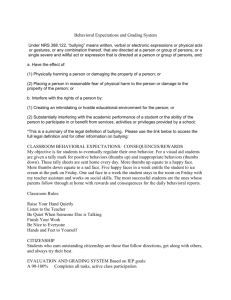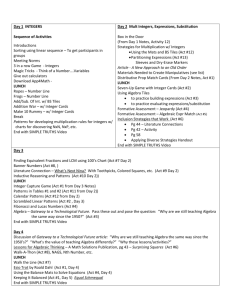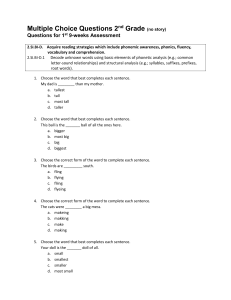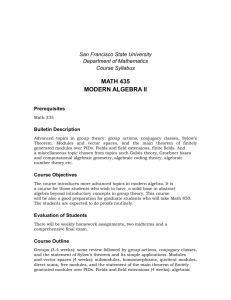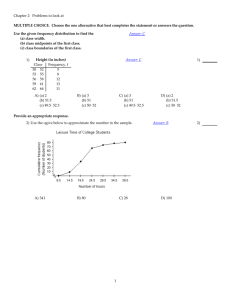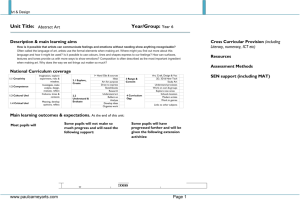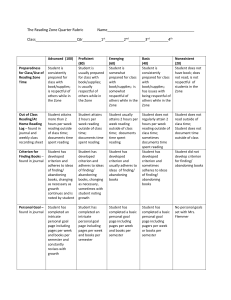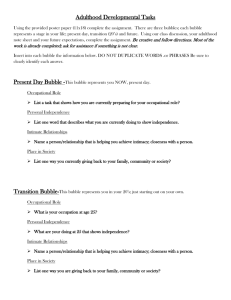Ch 14 Practice Test - Gordon State College
advertisement
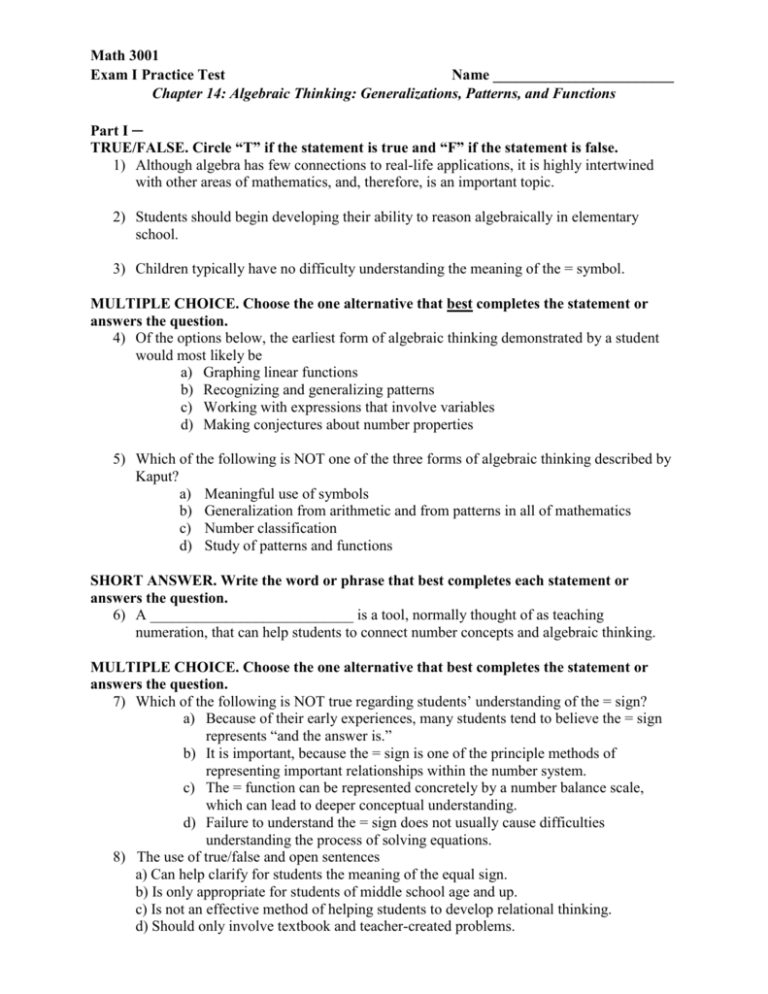
Math 3001 Exam I Practice Test Name ________________________ Chapter 14: Algebraic Thinking: Generalizations, Patterns, and Functions Part I ─ TRUE/FALSE. Circle “T” if the statement is true and “F” if the statement is false. 1) Although algebra has few connections to real-life applications, it is highly intertwined with other areas of mathematics, and, therefore, is an important topic. 2) Students should begin developing their ability to reason algebraically in elementary school. 3) Children typically have no difficulty understanding the meaning of the = symbol. MULTIPLE CHOICE. Choose the one alternative that best completes the statement or answers the question. 4) Of the options below, the earliest form of algebraic thinking demonstrated by a student would most likely be a) Graphing linear functions b) Recognizing and generalizing patterns c) Working with expressions that involve variables d) Making conjectures about number properties 5) Which of the following is NOT one of the three forms of algebraic thinking described by Kaput? a) Meaningful use of symbols b) Generalization from arithmetic and from patterns in all of mathematics c) Number classification d) Study of patterns and functions SHORT ANSWER. Write the word or phrase that best completes each statement or answers the question. 6) A ___________________________ is a tool, normally thought of as teaching numeration, that can help students to connect number concepts and algebraic thinking. MULTIPLE CHOICE. Choose the one alternative that best completes the statement or answers the question. 7) Which of the following is NOT true regarding students’ understanding of the = sign? a) Because of their early experiences, many students tend to believe the = sign represents “and the answer is.” b) It is important, because the = sign is one of the principle methods of representing important relationships within the number system. c) The = function can be represented concretely by a number balance scale, which can lead to deeper conceptual understanding. d) Failure to understand the = sign does not usually cause difficulties understanding the process of solving equations. 8) The use of true/false and open sentences a) Can help clarify for students the meaning of the equal sign. b) Is only appropriate for students of middle school age and up. c) Is not an effective method of helping students to develop relational thinking. d) Should only involve textbook and teacher-created problems. SHORT ANSWER. Write the word or phrase that best completes each statement or answers the question. 9) The ☐ in an open sentence plays the same role as a __________________, which frequently takes the form of a letter. MULTIPLE CHOICE. Choose the one alternative that best completes the statement or answers the question. 10) Which of the following is NOT a true statement regarding simplifying expressions and equations? a) For many students, they have been abstract, meaningless tasks. b) They are not essential skills to working algebraically. c) They are specifically mentioned in the NCTM Curriculum Focal Points. d) Students can gain a better understanding if they examine examples with errors and explain how to fix them. 11) When helping students to develop a conceptual understanding of number properties, it is helpful to a) Provide students with a list or properties to examine and memorize. b) Build them into students’ explorations with number sentences. c) Encourage students to only use mathematical symbols to express the properties. d) Discourage students’ conjectures, as they lead to confusion. 12) Which of the following is a true statement about repeating patterns? a) Children’s literature is not a good source of examples. b) The core of the pattern is the string of elements that repeats. c) It is overly confusing to show young children the same pattern constructed with different materials. d) It is difficult, but worthwhile, to find examples from the real world. 13) Growing patterns a) Are frequently functions. b) Are best represented by numbers only. c) Should not include fractions and decimals. d) Have either a recursive formula or an explicit formula. TRUE/FALSE. Circle “T” if the statement is true and “F” if the statement is false. 14) Students are more likely to describe the explicit formula for a function verbally before they will be able to describe it symbolically. SHORT ANSWER. Write the word or phrase that best completes each statement or answers the question. 15) The rate of change of a linear function can be determined from a graph by examining the line’s _________. 16) Functions can be represented in five ways: context, table, verbal description, symbolic equation, or____________________. MULTIPLE CHOICE. Choose the one alternative that best completes the statement or answers the question. 17) When students create graphs of functions a) They are representing them in the manner that makes it the hardest to visualize relationships between patterns. b) They should place the independent variable (step number) along the vertical axis. c) It is helpful to provide them with examples within a real-life context. d) They should always be given specific data, equations, or numbers. 18) A proportional relationship a) Can only be represented with an equation. b) Will always have a graph that forms a straight line and passes through the origin. c) Will always have a positive slope. d) Is much more challenging for students to generalize than a non-proportional one. ESSAY. Write your answer in the space provided or on a separate sheet of paper. 19) Describe two different ways you could determine whether a function is linear. Describe how these two methods relate to one another, and a possible classroom activity that would help students to see this connection. 20) Describe three different ways algebra can be connected to other areas of the mathematics curriculum. Part II ─ 1. Use the following “algebra as generalized arithmetic” principle to complete the example that follows. a + b = (a – 2) + (b + 2) 22 + 38 = _____ + _____ = _____ 2. Fill in the blank. +7 3. True or False. (a) 3 + 7 = 7 + 3 4. 5. 8+4= _______ (b) 9 + 5 = 0 + 14 Solve for the missing value. (a) 15 + 29 = 11 x (b) 6 x n = 2 x 3 x 9 (c) 12 x (d) 3 + (n – 1) = 10 = 24 x 5 Solve for the value of the rectangular shape. _______ 6. A 10-foot by 10-foot pool is surrounded by two “rows” of tiles (as shown). The blue tiles represent the pool, and the beige tiles represent the border. Show two ways for counting the border tiles without counting each one. 7. Complete the following patterns. (a) 2, 6, 18, _____ , _____ (b) 1976, 1980, 1984, _____ , _____ (Summer Olympic years) (c) 4, 9, 16, 25, _____ , _____ (d) _______ (e) _______ _______ _______ ° ° (f) ° ° ° ° ° ° ° ° _______ _______ (g) B, D, F, H, _____, _____ (h) A, A, B, A, A, B, A, _____ , _____ 8. Show steps toward the solution of 12 – 3x = 2(1 + x). 9. Decide whether the following situation is a “balance” or “tilt”. (a) (b) (2 x 9) + 5 500 − 142 3 x (6 + 2) 253 + 159 Balance Tilt Balance Tilt 10. The “balance scale” diagram below shows x 2 x 3 . True or False. __________ If the statement is false, make any corrections needed to the equation. ________________________ 11. Express symbolically, using variables, the general property in algebra that each illustrates. Also name the property or properties. (a) (400 25) 3 (400 3) (25 3) (a + b) x c = (a x c) + (b x c) (b) 5.95 x 1 = 5.95 (c) 5 × (17 × 3) = 5 × (3 × 17) (d) -75 + (-23 + 75) = -75 + (75 + -23) = (-75 + 75) + -23 = 0 + -23 = -23 12. Give the 20th and the nth entries for these lists, assuming the patterns continue. (a) 1, 3, 9, 27, 81, … (e) 4, 9, 16, 25, 36, . . . (b) 5, 7, 9, 11, 13, … (f) 1, 3, 6, 10, 15, . . . (c) 2 12 , 4, 5 12 , 7, 8 12 , 10, … (g) 2, 6, 12, 20, 30, . . . (d) 13. 1 2 3 4 , , , ,… 2 3 4 5 (h) A, C, A, C, A, C, . . . Give the first four numbers of each of the following sequences. (a) An arithmetic sequence with first term 17 and common difference 10 (b) A geometric sequence with first term 3 and common ratio 2 (c) An arithmetic sequence with first term 50 and common difference -3 14. Figure out the weight of the three balls, given the following three facts. = 1.25 pounds = 1.35 pounds = 1.90 pounds 15. (a) (b) (c) (d) (e) 16. An application involving linear functions involves the relationship between Celsius and Fahrenheit temperature measurements. A common formula (in slope-intercept form) is F = 1.8C + 32 . The slope of this line is 1.8 and the y-intercept is 32 since 0˚C = ____˚F. Write the linear formula relating distance (d) and time (t) for a fixed rate of speed, r = 69 mph. d = _____________ Another common application involves cost structures. For example, an automobile mechanic may charge $238 for parts and $60 an hour for labor. Write the corresponding formula, with C for cost and t for time in hours. C = ____________________ 17. A T-shirt company has regular expenses of $5,000 per week in addition to a silkscreening expense of $1.25 per shirt. The company takes in $500 a week from investments they have made. They sell each T-shirt for $5.00 wholesale. (a) If this company sold 1,300 T-shirts, would there be a profit or a loss? How much? (b) If the company sold 1,075 T-shirts, figure out their profit or loss. 18. You and your roommates want to subscribe to a movie-rental service. You have two choices: Movies-R-Us charges $12/month, plus $4 per movie rented, See-It-Now charges $9/month, plus $5 per movie rented. (a) For each choice, write an equation giving the cost C for renting n movies a month. Movies-R-Us: ____________________ See-It-Now: ____________________ (b) Knowing that you would probably average renting 4 movies each month, which company would you choose? Explain your reasoning. 19. Make a distance-time and a speed-time graph for the following story. Let the distance refer to the distance from the cave. Use very similar scaling on the time axes. “Wile E. is in his cave and then walks slowly toward a canyon, planning to make a trap for Roadrunner. Halfway there, he stops for a short rest. Then, he jogs on to make up for lost time. When he gets to the canyon, he realizes that it is almost time for Animal Planet on TV, so he runs as fast as he can back to the cave.” 20. Make a distance-time and a speed-time graph for the following story. Let the distance refer to the distance from the cave. Use very similar scaling on the time axes. You walk for 5 minutes at 1 mile per hour, stop for 2 minutes to watch a nest of baby birds, and then walk for 10 minutes at 2 mph. Sketch a graph to display the relationship between the variables. Label the axes, using the vertical axis for the dependent variable. State any assumptions you make. 21. The temperature of Hannah’s hot chocolate change as it cools to 68°F (temperature/time) 22. Bethany concludes her piano recital selections. When she finishes, there is a stunned silence. Then the audience stands up and applauds loudly for several minutes. (time/noise level) 23. Joanna is driving on the highway with cruise control set at the speed limit. (speed/time) 24. When jogging, Lydia tries to start off slowly, build up to a comfortable speed, maintain that speed for a while, and then sprint to the finish at the very end of the run. Then she walks a while. (time/speed) 25. During the past few years, the population of a certain city has grown at a slower rate than ever before. (population/time) Do your best! Rise to the challenge! Live and learn!


